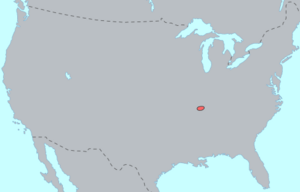Ofo language facts for kids
Quick facts for kids Ofo |
|
|---|---|
| Native to | United States |
| Region | Mississippi |
| Ethnicity | Mosopelea |
| Extinct | early 20th century |
| Language family |
Siouan
|

Distribution of Ofo language
|
|
The Ofo language was a language spoken by the Mosopelea tribe. They spoke it until around 1673. At that time, they lived in what is now Ohio, along the Ohio River. Later, the tribe moved south along the Mississippi River to Mississippi. They settled near the Natchez people. After that, they moved to Louisiana, living close to the Tunica tribe.
In the 1700s, people knew the Mosopelea tribe by names like Oufé and Offogoula. Because these names had an "f" sound, some people thought Ofo might be a Muskogean language. However, in 1908, an expert named John R. Swanton met an elderly woman named Rosa Pierrette. She was the last known speaker of Ofo. Swanton was studying the Tunica people when he found her. Rosa Pierrette had spoken Ofo when she was a child. She told Swanton that the rest of her tribe "had killed each other off" when she was 17. Swanton was then able to confirm that Ofo was a Siouan language. He found it was similar to the Biloxi language.
Contents
How Ofo Words Work (Morphology)
Ofo is a language where words can be quite long. This is because many parts are added to a single word to give it meaning. This type of language is called a polysynthetic language.
Showing Who Owns Something (Possession)
In Ofo, you show who owns something in two ways. This depends on whether the item is "alienable" or "inalienable."
- Alienable possession means something you can give away. Think of a toy or a book.
- Inalienable possession means something you can't easily give away. This includes body parts or family members.
Ofo used special prefixes (small parts added to the beginning of a word) to show who owned something. These prefixes changed for "I," "you," "he/she/it," and "we" (two people).
Saying "No" (Negation)
To make a sentence negative in Ofo, like saying "not" or "don't," they added a special ending. This ending was -ni. It usually came after the main action word (the predicate).
Making Things Plural (Pluralization)
To show there was more than one of something, Ofo used the ending -tu. This ending could be added to the subject (who is doing the action) or the object (who the action is done to), or both.
Action Words (Instrumental Prefixes)
Ofo used special prefixes to describe how an action was done. These are called instrumental prefixes. They tell you if something was done by hand, by mouth, or by striking, for example.
Here are some examples:
- atə- means 'by extreme temperature' (like by burning or freezing).
- tu-, du- means 'by pulling' or 'by hand'.
- ta- means 'by mouth'.
- pa- means 'by pushing'.
- la- means 'by foot'.
- ka- means 'by striking' (like hitting).
- pú- means 'by pressure'.
- po- means 'by blowing' or 'by shooting'.
Who is Doing What (Pronouns)
Ofo had words for "I," "you," "he," and "we." These are called pronouns.
| "mí̃ti, mí̃*te" 'I, me' | "čí̃*ti" 'you' |
| "í̃*ti" 'he' | "á̃ti, á̃*ti" 'we' |
Grammar and Gender
Ofo did not seem to have grammatical gender. This means words for things like "table" or "chair" didn't have a "male" or "female" form, unlike some other languages.
Time and How Actions Happen
Ofo had ways to show when an action would happen or how it was happening.
Future Actions (Irrealis Mood)
The Irrealis mood in Ofo was shown with the ending -abe. This was like saying something "will" happen in English.
- óktat-abe means 'he will kill you'.
- tcóktat-abĕ means 'you will work'.
- atcikthé-be means 'I will kill you'.
Ongoing Actions (Continuative Aspect)
To show an action was continuing or ongoing, Ofo used the word nóñki.
Repeated Actions (Iterative Aspect)
Ofo showed that an action was repeated by saying part of the word twice. This is called reduplication.
- è-te-te' means 'sick, keep on suffering'.
- šni-šni-we means 'itch, keep on itching'.
- tó-fku-fku-pi means 'wink, blink, keep on winking or blinking'.
How Ofo Sentences Are Built (Syntax)
We don't have enough information about Ofo to know everything about its sentence structure. However, we do know some things that are also found in related languages.
Ofo sentences usually put the main action word (the verb) at the end. This means the object of the sentence often comes before the verb. For example, instead of "I hit you," it might be more like "I you hit."
Here's an example:
b-aphú̂ska
my-fist
a-tci-tp-ábe
I-you-hit-IRR
'I will hit you with my fist'
Special Word Endings (Case)
Because we don't have many examples of Ofo, only some special word endings are known.
Ofo had something called Dative case. This is similar to how we use an accusative pronoun in English. It shows who is receiving the action.
Here are some examples:
tcilétci
your.tongue
ó̃tcĭku
me.you.give
'hold your tongue!'
athé
dress
ãtcókpe
me.you.put on
'you help me dress'
Causes and Results (Causatives)
We don't have much information about how Ofo handled complex sentences. However, we do know that if one part of a sentence depends on another, the dependent part usually comes first.
For example:
détõ-ni
(he).go-COND
á-kiu-bĕ
I-come-IRR
'if he goes, I will come'
To show that something causes an action, Ofo used the ending -we.
ifphé-we
teach-CAUS
'to teach'

